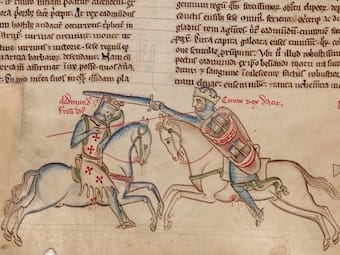After the setback at Assandun in 1016, King Edmund Ironside continued his dogged resistance to Cnut’s Danish invasion. But when the two armies met near Gloucester, it was decided that, to save bloodshed, the rivals for the crown should settle their dispute by single combat; and thanks to their well-made armour, the fight came quickly to swords at close quarters.
The two kings were well-matched, but such was Edmund’s skill as a warrior that at last even the mighty Cnut was forced to offer terms. To the joy of both armies, the rival kings agreed to rule together over England, and even over Cnut’s realms in Denmark and Norway, and sealed their oaths with the kiss of peace.
117 words



